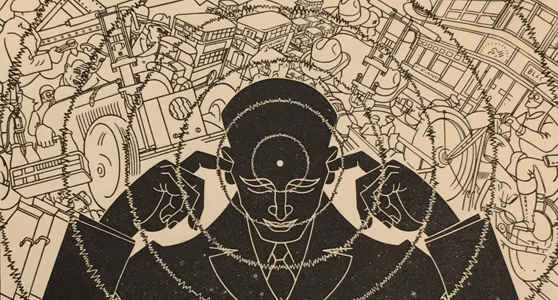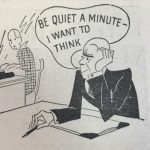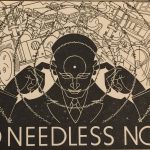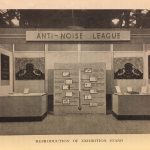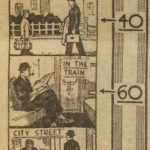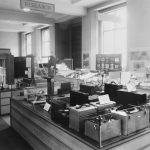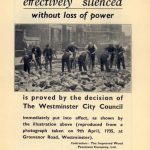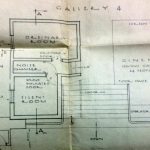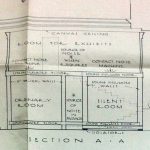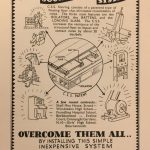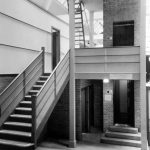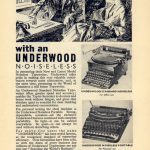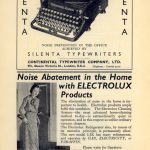‘A Chamber of Noise Horrors’: sound, technology and the museum
Abstract
https://dx.doi.org/10.15180/170704/001This article examines the 1935 Science Museum temporary exhibition on Noise Abatement, situating it in the sound historical context of inter-war Britain, and making an argument that the ‘way of hearing’ it advanced was part of an attempt to shape auditory perception in the interests of a class-bound culture of acoustic civilization. Further, the article uses this exhibition to mount an argument that museum scholars should consider sound not simply as a medium of engagement, but also as a politically interested and socially active field.
Keywords
exhibition history, museums, noise, Science Museum, sound, Technology
Introduction
https://dx.doi.org/10.15180/The Science Museum, London, is a noisy place. Like others of its kind, it resounds with excited hubbub thanks to its enormous popularity as a family museum. Unlike art galleries, where exhibits have traditionally been silent, science and technology museums are also full of things that once made a tremendous racket. In contrast to their noisy visitors, these artefacts are usually silenced in the museum, their sounds deadened by the demands of preservation and the practicalities of display. Artefacts in glass cases become objects of visual contemplation only, despite having previously been heard, handled and sensed in other ways. New approaches to museum materiality have begun to address the question of tactility (Howes, 2014), but the sonic dimensions of museum objects have not yet received the same kind of attention, despite the relevance to science and technology museums of a new sound studies scholarship pointing to sound control and reproduction as a central feature in the story of modern technological revolution (e.g. Sterne, 2003), and to hearing as a fundamental component of the social reception of technology (e.g. Bijsterveld, 2008). To tell the story of modern science and technology, in other words, we need to make more of a noise.
The problem of how to re-sound the history of science and technology in the museum is multi-faceted and only partly addressed using digital audio, which cannot ultimately do justice to pre-digital sound technologies and sonic experiences. New approaches to multi-sensory engagement in museums, and particularly new techniques for ‘soundtracking’ exhibitions (Bubaris, 2014), point to some ways forward, but my approach in this article is to consider the question of sound not from a practical point of view, but rather from a critical-historical one, though I suggest that the latter should pre-figure the former.[1] In response to the new museums studies literature that champions sound as a technique of visitor engagement, I draw upon the ‘ways of seeing’ approach that has been so fruitfully applied to the visual culture of museums (Bennett, 2011; Rees Leahy, 2014) to discuss how exhibitions also organise and promote ways of hearing. To do this, I take the example of a 1935 Science Museum temporary exhibition on Noise Abatement – described in newspaper coverage at the time as a ‘chamber of noise horrors’ – as my case study.[2] My analysis of this exhibition adds further weight to Jennifer Rich’s argument (in this issue) that the Science Museum has a long, though sometimes controversial, tradition of engaging its visitors through the medium of sound (see also Rich, 2016). I will argue that although it may certainly be a useful medium for generating new kinds of engagement in museums, because sound is routinely invested with affective-ideological power and organised for social purposes, its use in museums must be subject to critical as well as to practical consideration. Analysing past museum practice within the terrain of a wider history of sound can help us to think in more sophisticated ways about what sound is and about what sound does. The 1935 Noise Abatement exhibition provides a useful case study because it was staged at a time when urban and technological noise was being invested with ideological significance as part of a cultural conflict over scientific and technological progress in which class-bound notions of acoustic civilization were being promoted as norms for the nation (Mansell, 2017). Sound is thus not merely an illustrative tool in the science and technology museum, but an inherent component of technology’s vibrant history. The first section of the article sets out my argument about ‘ways of hearing’ in relation to existing museum studies literature on sound. The second section introduces the organisation that staged the 1935 exhibition, the Anti-Noise League, and the historical contexts, and class-informed ‘ways of hearing’, in which it operated. The third section examines the use and representation of sound at the 1935 exhibition. It points out that sound has already had a place in exhibition practice, and makes an argument for incorporating historical ways of hearing into our understanding of the history and material culture of technology.
Sound and the museum
https://dx.doi.org/10.15180/170704/002Museums are increasingly seeking ways to engage their visitors through sound as part of a wider trend toward what Bubaris (2014) has termed the new ‘experience’ economy in heritage practice. This is not usually an ‘abstract or theoretical concern’ with experience, but refers, rather, to ‘well-designed means for attracting cultural consumers by catering to their needs in a stimulating environment of sought-after memorable events’ (Bubaris, 2014, p 393). Writing in the Museums Journal, Sharp (2013) further suggests that sound effects in museums are primarily a ‘cost-effective means of engaging visitors’, providing ‘an immersive experience’ to enhance or replace the traditional object-plus-text exhibition format. Museum scholars have nevertheless welcomed this turn to sound as a necessary corrective to the ‘pervasive and long-standing belief that museums are places of silence’ (Bubaris, 2014, p 391). In museums, according to Bubaris, ‘a meaningful sound environment’ can now rightfully become a ‘valuable practice of knowledge,’ drawing us into embodied connection with artefacts and their stories (Bubaris, 2014, p 391–392). Scholarly celebrations of the possibilities of museum sound tend to focus on the argument that sound may facilitate the multiplication of narrative and interpretation in exhibitions. Bubaris argues that ‘The sonic culture of silence is intertwined with the communicative model of transmitting precisely defined cultural information – the cultural equivalent of a metaphysical presence speaking the truth as the ultimate source of knowledge’, whereas a sound-rich exhibition is better suited to ‘an open and pluralistic museum’ where ‘multiple interpretations’ are possible (p 400). Boon (2014), similarly, hopes that sound, and musical sound in particular, will allow for the opening up of available meanings and experiences in the space of science museums, confounding misplaced confidence in ‘the precise clarity of science communication’. Boon argues that music opens ‘inexplicit territories of meaning’ for visitors, who may in turn ‘poach’, in Michel de Certeau’s sense, what they need from an exhibition, becoming ‘secondary producers’, to use de Certeau’s language, or ‘co-producers’, to borrow Helen Graham’s (2016). There is evidence to suggest that sound may successfully facilitate plurality and multiplicity in museum display where controversial and contested historical topics are concerned. Hutchison and Collins (2009) argue that sound installation provides opportunities to create the ‘polyphonic’ and ‘dialogic’ exhibitions necessary to account for multiple perspectives on migration history, for example, and point to the value of oral history recordings as a way of presenting multiple pasts and drawing visitors into an empathetic relationship with personal testimony. Binter (2014) advocates sound as a means of reframing the history of colonial encounter in ethnographic museums. According to Binter, contextual oral history audio used alongside exhibits allows the curator to challenge both ‘conventional occularcentric forms of display’ (p 343) and the structures of power inherent in imperial collecting.
What unites the existing literature on museum sound is thus a positive outlook on the sonic in which vision is associated with the old structures of authority and sound with an emancipatory opening of the museum to personal experience and to formally excluded perspectives. While Boon (2014) is right to lay down the challenge that ‘Most museums devote much thought to how they look and virtually none to how they sound’, my argument is that in thinking through museum sound we should be as critical about what sound does as we have come to be about what vision and the visual field can do. We should pause to question whether sound automatically offers a more democratic and pluralistic way of doing exhibitions, and whether it really is as straightforward a way around the ‘visual hegemony’ and ‘occularcentrism’ of western modernity as some have suggested. In cases such as those mentioned by Hutchison and Colins and by Binter, curators were already thinking critically about the politics of heritage and display, but where this is not the case, it may be all too easy for sound’s routine involvement in hegemonic power – for sound is no less implicated in power than vision – to be reproduced in the museum or heritage space.
Tourle’s critique (2017) of the British Library/National Trust project Sounds of Our Shores offers a cautionary tale and a necessary corrective to unqualified enthusiasm about sound in museum practice. Sounds of Our Shores ‘is a community-led, interactive soundmap’ created in the summer of 2015. It was crowd-sourced by users who were asked to ‘upload their favourite seaside sounds and help build a permanent digital resource of UK coastal recordings’ (British Library). The project was intended to promote attentive listening as a means of generating appreciation of ‘the beauty and diversity of the entire UK coast’ (National Trust). Tourle argues that despite taking the appearance of an open and democratic exercise in crowd-sourcing sonic heritage, the Sounds of Our Shores project in fact directed its users in a particular ‘mode of listening’ (p 238). He argues that in its emphasis on natural beauty, the promotion of the project to contributors explicitly situated the listening mode as touristic. The project ‘discursively privileged and materially preselected sounds that reproduce the coast as a site of leisure and natural beauty’ (p 243). Tourle points out that the conceptualisation of the coastline as natural resource, generated by the predominant acoustic ecology logic in sonic heritage practice, diverted attention away from coastal areas as places where working-class communities ‘live, work and struggle’ (p 242) and, more unfortunately still, served to occlude the role of the British coast as an imaginative frontier and site of noisy protest during the ‘migrant crisis’ that coincided with the collecting phase of the Sounds of Our Shores project. Tourle concludes that even as the project ‘opened up the sonic environment to its audiences as a new field of experience’, its setup ‘worked to discipline public listening, aestheticising and domesticating the sonic, wresting from it the power to disrupt hegemonic narratives of nation’ (p 244). Sure enough, in a subsequent poll run by the National Trust to find ‘the UK’s favourite coastal sound’, the ‘sound of gentle waves breaking on the beach’ came out on top (National Trust). Tourle’s theorisation of socially-shaped modes of listening, a concept he borrows from sound studies and critical race theorist Jennifer Stoever-Ackerman (2010), and his investigation of the ‘boundaries of acceptable listening’ operating in heritage practice (p 244), open the critical terrain which should in my opinion be necessary to those wishing to work with sound in museums. The Sounds of Our Shores project did not set out to silence the noise of protest, quotidian drudgery or cries for help, but nevertheless did so by framing the sonically valuable in such a way as to foreground particular national and class modes of listening.
Ironically, perhaps, the museum studies literature on ‘ways of seeing’ further maps out the kind of critical attention to sound that I wish to make a case for here. Theorists of the senses argue that the encounter between a visual object and a seer must be socially shaped to be made meaningful. Howes and Classen (2014) argue that ‘Perception is informed not only by the personal meaning a particular sensation has for us, but also by the social values it carries’ (p 1). Museum theorists such as Bennett (2011) argue that museums shape visual perception in the interests of certain fields of visual meaning at the expense of others. Bennett points to the ways in which nineteenth-century museums, for example, promoted Darwinistic ways of seeing nature. The effect described by Bennett was achieved in the museum by explainers and textual information, but also by the visual logics of collecting and display. Rees Leahy (2014) notes that in attempting to re-stage historical art exhibitions, curators must appreciate the importance of the ‘period eye’, a particular way of encountering visual imagery specific to an historical period, or, to put it another way, ‘the cultural-constructedness of vision’, or a ‘set of viewing norms’ (p 286) which both artists and gallery-goers understood at the time of an original exhibition, but which no longer translate straightforwardly into our changed ways of seeing. Such theories of the historical shaping of sight are now widely accepted and understood, but are not routinely applied to sound.
Yet our perception of sound is also shaped socially. We hear historically. Sound is not intrinsically multiple, dialogic or pluralistic, but may be presented as such in a museum ‘way of hearing’. Museums are, in fact, powerful shapers of our social ways of encountering sound because they have the authority and opportunity to direct sonic behaviour and perceptual attention. The expected norm of quietly contemplating an art work was actively produced by those who sought to use the art gallery as a tool of civilization (Hill, 2005). Bubaris (2014) notes that ‘It is no coincidence that sound is more acceptable in museums that do not have the ‘aura’ of high culture, for example, in science centres and temporary exhibitions, rather than in the permanent collections of art museums’ (p 392). This same process was at work in the way that concert hall audiences were enculturated into certain ways of behaving around symphonic music, sitting silently during and even between movements and clapping at the appropriate time. Johnson (1995), Weber ( 1975) and others have pointed to these sonic codes of conduct, which rarefied ‘absolute music’, as fundamental to the coming into being of middle-class identity and the rise of notions of civility in the nineteenth century. Quiet, in this context, became loaded with class connotations, a consequence of civilization rather than an acoustic category. It operated, powerfully, in the class-bound social imaginary of early twentieth-century Britain, as the next section of this article will show. If, as Rich suggests (this issue), we have overlooked the extent to which sound has historically featured in museums, then we must certainly have been inattentive to the extent to which museums, perhaps no less than concert halls, organised and shaped historical, class-bound, or otherwise socially-interested, ways of hearing. What is audible or otherwise, and what is auditorily welcomed or rejected, is no less of an historical or political matter than what the visual field does or does not admit as knowable and true. We must, therefore, do more to take account of museum ways of hearing.
The Age of Noise and the Anti-Noise League
https://dx.doi.org/10.15180/170704/003The Science Museum’s 1935 temporary exhibition on Noise Abatement is an example of an exhibition which both foregrounded sound as a primary mode of engagement and which sought to shape a particular way of encountering sound. Noise loomed large in the early twentieth century. A technological revolution begun in the nineteenth century, progressing apace in the twentieth, was perceived to have fundamentally altered what the world sounded like. The buzz of telephones, gramophones and radios, the rumble of aeroplanes, trains and motorcars, and the mechanical thundering of the Great War, permeated cultural and social discourse, providing a reference point for those trying to make sense of the tumultuous transformations unfolding around them (Bijsterveld, 2008; Halliday, 2013). Newspaper correspondents and cultural commentators described this as the ‘age of noise’, indicating the significance they attributed to their changing sonic environment as a barometer of wider historical change (Mansell, 2017). Noise had a distinctly negative connotation in this context, encapsulating anxieties about living in a modern industrial society (Mansell, 2014). As this and the following section will make clear, the negativity with which noise was viewed came to be parcelled up with class as well as gendered notions of what acoustic civilization should sound like. Noise was held to be damaging primarily because it disrupted the capacity of professional, middle-class, men to exercise their intellectual leadership. ‘Noise’ in this context meant the technological sound worlds of mass society intruding into the quiet sanctum of the office or the suburban home or otherwise residing there as gendered ‘friction’, as in the illustration in Figure 1 which accompanied a 1935 advert for the Remington Noiseless Typewriter, showing the disturbance to the professional male office worker caused by his female typist.
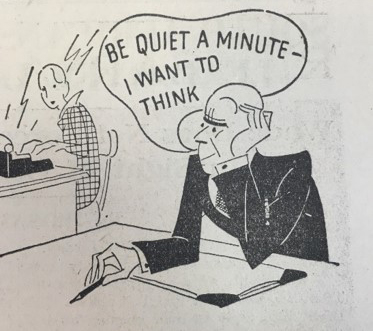
Even professional acousticians such as G W C Kaye, who led a pioneering programme of acoustics research at the National Physical Laboratory in the 1930s (Goldsmith, 2012), defined noise not primarily as a scientific category (on which see Wittje, 2016), but as a social one, calling it ‘sound made by some one else’. He added that ‘a hearer of a particular sound called it a noise if he himself did not desire it, regardless of whether his neighbour did or did not similarly find it a nuisance’ (Anti-Noise League, 1935b, p 7). Kaye was himself particularly exercised by the poor etiquette of motorcar and motorbike drivers racing on city streets and sounding their horns unnecessarily, the subject of an audio-illustrated talk he gave on BBC Radio in 1935, which you can hear in the extract below.
For architectural acoustician Hope Bagenal, it was the ‘menace of the loudspeaker’ attached to the gramophone or wireless set that posed the greatest threat to auditory privacy in the ‘age of noise’. “Do you realise,” he asked at a talk in the Science Museum lecture theatre in 1935, “that your neighbour may at any time put at the other side of your party wall an instrument capable, with suitable room resonance, of developing anything up to 85 or 90 decibels, nearly as much as a loud sports car or road drill, and capable of setting all thin walls and floors in vibration? And he may keep it on for hours” (Anti-Noise League, 1935b, p 23). Such was Bagenal’s antipathy to the wireless, and particularly to the ‘wireless fan’ thoughtlessly and noisily ‘seeking foreign stations with a powerful set at night’, he suggested that blocks of working-class flats (where appreciation of quietness was deficient) should have their sets controlled by a building attendant who would manage the volume and the times at which users could switch their sets on (Bagenal, 1938, p 17).
Growing concern about the auditory chaos of modern urban life led to the formation of organised noise abatement campaigns in several industrialised nations, including in Britain (Bijsterveld, 2008). The Anti-Noise League, whose logo appears in Figure 2, was formed in London in 1933 to act as a national focal point for noise abatement campaigning with a prominent doctor, Thomas Jeeves Horder (by this time sitting in the House of Lords as Lord Horder), at its helm. The sounds of new mass consumer technologies were the key targets of the League’s campaign to suppress ‘needless noise’. Motor traffic and domestic loudspeakers were frequent targets of its campaigning. At the time of the Noise Abatement Exhibition which the League staged at the Science Museum in 1935, its activities fell into two distinct areas. On the one hand, it sought to influence local and government policy relating to noise nuisance and planning against noise. On the other, the League sought to educate the public about the dangers of noise.
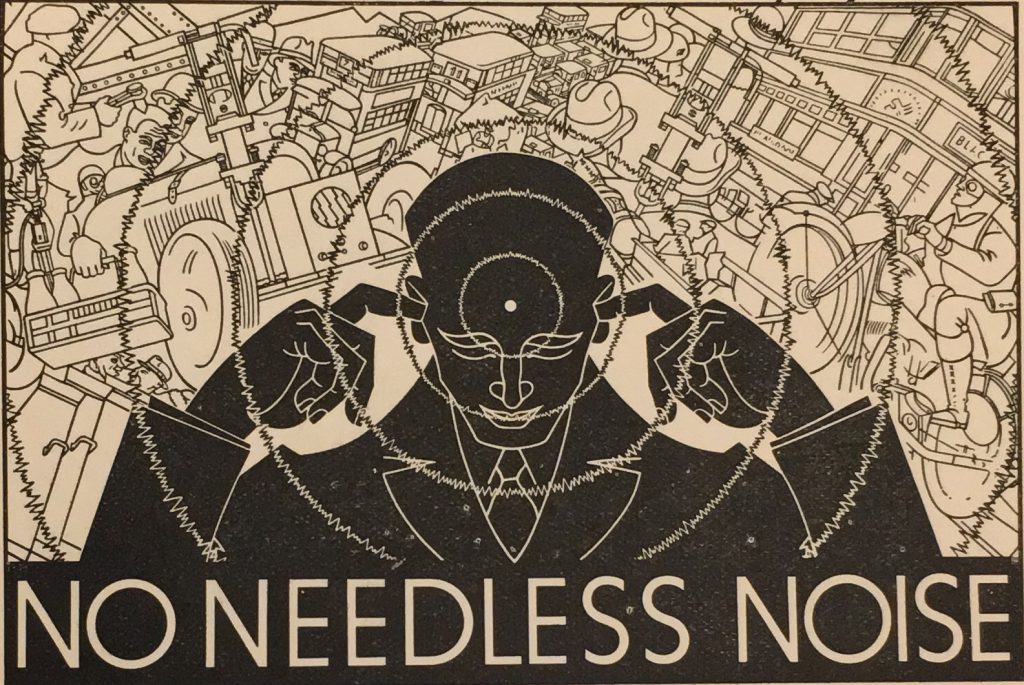
In both cases, the League’s case against noise pivoted on a medical argument that noise causes fatigue and mental illness thanks to the irregular vibrations that it brings to bear on the human body’s nervous system. In his contribution to the Anti-Noise League conference held to mark the end of the 1935 Noise Abatement Exhibition, Horder pitted the human mechanism against technology, insisting that ‘we have let our inventive faculty get ahead of the capacity of our anatomy and physiology (as expressed by the part of these which is most vital, namely, our nervous system) to stand up against the results of our ingenuity’ (Anti-Noise League, 1935b, p 44). In both its behind-the-scenes lobbying and in its public advocacy, noise was held by the Anti-Noise League to be a cause of ‘neurasthenia’, today a more-or-less discarded psychiatric category, but at the time a diagnosis much popularised not only by doctors but also by fiction and self-help writers as an illness affecting the ‘nerves’ of the cultivated classes (Mansell, 2014; Mansell, 2017). In his contribution to the 1935 exhibition handbook (Anti-Noise League, 1935a), Horder wrote that ‘Doctors are definitely convinced that noise wears down the human nervous system’; it ‘jars and fatigues, by constant tension, the nerves of the normal citizen’ (pp 1–2). Horder knew that in order to gain the support of government ministers he would have to convince them that noise-induced neurasthenia would affect even the ‘normal citizen’ but admitted elsewhere that it was really to the ‘intelligent section’ of society that his League appealed (Anti-Noise League, 1935b, p 43).
One does not have to read too far between the lines to find that 1930s anti-noise discourse contained as much distaste for social change as it did medical evidence. For those who did not understand the appeal of quiet, Horder suggested ‘a national park with cheap trains and buses to and fro, where these primitive and immature citizens may be let loose, to yell and make other noises to their hearts’ content’ (Anti-Noise League, 1935a, p 2). When Horder claimed that ‘our senses are essential to our sense’ (Anti-Noise League, 1935b, p 44) he meant that the quiet culture of middle-class self-formation, associated with the art gallery, the concert hall, and the suburban home, had to be protected from the potential of mass, popular culture – implicitly that of the working and lower classes – to overwhelm it with the noise of sports cars, gramophones and wireless sets. The Anti-Noise League thus promoted a way of hearing modern technological noise that cast it as uncivilized, selfish and inefficient, for it was said to waste the energy and working capacity of those who would otherwise lend society their intellectual labour.
Showing sound, cultivating listeners
https://dx.doi.org/10.15180/170704/004The Anti-Noise League’s first annual conference took place at the University of Oxford in 1934 and included ‘demonstrations and exhibitions of “silencing” experiments’.[3] It was resolved that in the following year a more public exhibition of this kind was needed to broaden the League’s appeal beyond the medical men who had founded it. The Noise Abatement Exhibition held at the Science Museum between 31 May and 30 June 1935 was to be that event. In his lobbying of the Ministry of Health, Horder had been repeatedly frustrated that government policymakers did not take the health case against noise seriously (Mansell, 2017). Worse, where state-sponsored investigation of noise and health had taken place in the 1930s, the government’s Department of Scientific and Industrial Research had tended to favour the expertise of industrial psychologists rather than the general medical profession. The industrial psychologists, such as Millais Culpin, who investigated the effects of noise in the workplace under the auspices of the Industrial Health Research Board, rejected the arguments made about noise and neurasthenia and concluded that noise sensitivity was not a physical cause of mental illness, but was rather a symptom of it (Mansell, 2017). This allowed the Industrial Health Research Board to conclude that noise was not a significant factor in workplace efficiency, and even to recommend the inclusion of more noise in the factory in the form of BBC ‘Listen While You Work’ broadcasts designed to alleviate boredom (Mansell, 2017).
Faced by the indifference of the Ministry of Health and by rebuttals and reprimands from the Industrial Health Research Board, the Anti-Noise League hoped that a Noise Abatement Exhibition at the Science Museum would not only raise the public profile of the noise abatement cause but also generate sympathy and understanding within the various public and private organisations whose co-operation would be essential if the League’s aim of banishing ‘needless noise’ was to be realised. In the inter-war period the Science Museum was not primarily the educational organisation it is today. It was, rather, a place where leaders of the industrial and scientific worlds could be influenced in the national interest (Scheinfeldt, 2010, pp 52–55). Many of the temporary exhibitions held there in the 1930s took the form of trade shows in which commercial organisations, such as the Rubber Growers’ Association, could promote the utility of their products for industry. While the Science Museum was careful to maintain neutrality in matters of commercial competition (for example at its temporary television exhibition of 1937, which took place during a peak period of competition between different broadcasting technology manufacturers) it was nevertheless possible for an organisation like the Anti-Noise League to use the opportunity of exposure at the Museum for the purposes of generating credibility for a product or a cause. The Science Museum provided the ideal institutional stage upon which to bring together relevant government ministries and research agencies as well as a wide range of commercial organisations under the ‘Noise Abatement’ umbrella. Even the Industrial Health Research Board took part despite their open hostility to the noise abatement project. This did not indicate any new shared ground with the Anti-Noise League, but rather a willingness to take the opportunity to lay out the new dispassionate sciences of noise alongside the Anti-Noise League’s populist campaigning tactics.
Indeed, the Noise Abatement Exhibition took the form of a coming together of the various public and private bodies with a vested interest in the ‘noise’ question into a forum where approaches and expertise could be compared. Many of the exhibits were lent by the commercial organisations who had pioneered ‘quiet’ and ‘silent’ technologies in the 1920s and 1930s in response to concerns about the ‘age of noise’. Fourteen of these companies each contributed £10.10.0 to the costs of the exhibition as a way of securing involvement.[4]
When initial planning for the exhibition began in earnest in December 1934 the proposal was to design an exhibition with four distinct sections: health and noise; research and development; transport and machinery; and buildings. Each section was to be organised by an exhibition sub-committee chaired by an Anti-Noise League insider but made up of a wide range of noise experts. Lord Horder himself was due to chair the health and noise committee. The research and development committee chair was given to G W C Kaye, a powerful ally of the League given his prominent position at the National Physical Laboratory. Thomas Cave-Browne-Cave, a former RAF engineering officer and current Professor of Engineering at University College, Southampton, who was at the time researching ways to quieten motorcycle engines, chaired the transport and machinery committee. The buildings committee was chaired by architectural acoustician Hope Bagenal who had close ties to the Royal Institute of British Architects. Committee members, in contrast, were there to be influenced. The research and development committee, for example, included representatives from the Industrial Health Research Board, the London School of Hygiene and Tropical Medicine (which was closely associated via personnel with the Industrial Health Research Board), the Aircraft Defence Experimental Establishment, the Western Electric Company, the BBC and the Home Office Industrial Museum. The buildings committee included representatives from the Ministry of Health, the Office of Works and the Building Centre as well as Newalls Insulation Company, the Rubber Growers’ Association, and acoustic building supply specialists Honeywell and Stein and Horace W Cullum and Co. It is evident that despite the exhibition-by-committee planning format and the donations from private companies, and even though a Science Museum curator, Herman Shaw, sat on the various planning sub-committees, this was most certainly an exhibition led by the Anti-Noise League, as was typical of Science Museum temporary exhibitions at this time. The Executive Committee of the League co-ordinated the overall planning of the exhibition under the direction of its Chairman, Sir Henry Richards, a Chief Inspector of Elementary Schools.
Despite the Anti-Noise League’s tight grip on the exhibition organisation, tensions became evident in the planning stages. When the sub-committees began to meet for the first time in January 1935, the health and noise section had been axed and a decision taken to organise the exhibition around the remaining three sections only. Health-related research was instead incorporated into the research and development section where, it is no coincidence, the Industrial Health Research Board was a prominent contributor. Although the surviving records do not give any clear indication of why the decision was taken to discard the health section of the exhibition, it seems likely that it was caused by the disagreements, and competing ways of hearing, operating between the medical leaders of the Anti-Noise League and those conducting state-sponsored research into the health effects of noise at the Industrial Health Research Board such as the Cambridge psychologist, F C Bartlett, who despite publishing a prominent book on noise in 1934 – The Problem of Noise – is conspicuous by his absence on Anti-Noise League membership lists. It was perhaps a condition of the Industrial Health Research Board’s involvement in the exhibition that a balanced view be given of the current state of research on noise and health, with the Anti-Noise League’s case relating to nerves and neurasthenia pushed to the background in favour of industrial psychology research. Perhaps Horder was just too busy to take an active part in the exhibition planning. It is noticeable, however, that his medical colleagues on the Anti-Noise League executive committee, such as Dan McKenzie and the psychiatrist James Purves-Stewart, also seem to have taken no active part in organising the exhibition. Horder also complained, while chairing a session of the Anti-Noise League’s annual conference on the final weekend of the Noise Abatement Exhibition, that ‘he would have expected’ health ‘to appear higher on the list’ of matters to be discussed, hinting at some of the disquiet that evidently existed among the medical leaders of the League about the side-lining of medicine in the exhibition (Anti-Noise League, 1935b, p 7).
The Anti-Noise League’s populist critique of noise as a public health hazard was limited to its own campaign materials of the kind shown in Figure 3, in which a large mock thermometer represented the supposed increasing health risk of different intensities of noise, from a ‘cat purring’ and a ‘child whispering’ at the bottom of the thermometer to ‘piano practice’ and ‘loud conversation’ in the middle, to ‘gunfire’, a ‘roaring lion’, a ‘pneumatic drill’ and an ‘aeroplane engine at 10 feet’ at the top. A stand of this kind formed part of the Anti-Noise League’s contribution to the exhibition. In the image in Figure 3 (probably taken at another temporary exhibition rather than at the Science Museum), either side of the thermometer were placed large reproductions of the Anti-Noise League’s logo and posters which read ‘Help to Banish Unnecessary Noise’ and ‘Quiet Brings Comfort, Health and Efficiency’. Noise ‘thermometers’ of this kind were frequently used to illustrate newspaper reporting of the noise problem in the 1930s.
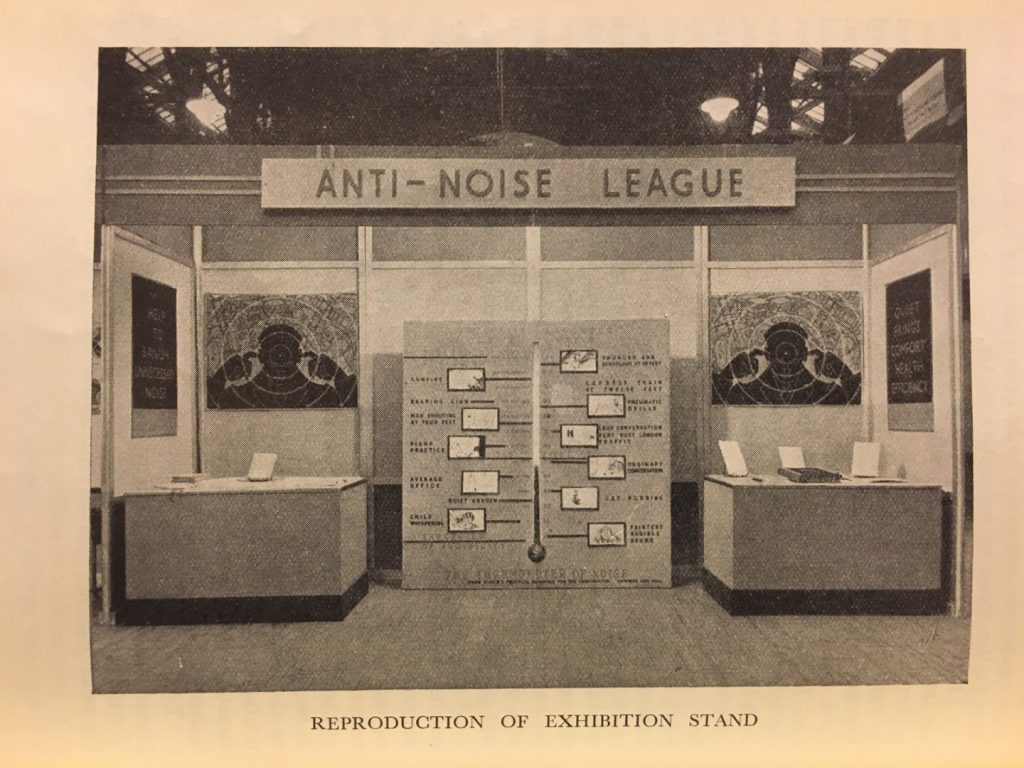
The example in Figure 4, published to accompany an article in the Dundee Courier and Advertiser in 1935, is indicative of the wider trend, and is typical of such illustrations in emphasising the rising decibel level from the quiet suburban home to the noisy city street and in drawing attention to the professional male worker as the sufferer from noise. This visualisation typifies the noise abatement ‘way of hearing’ everyday sounds. However, the popular medical theories about noise and neurasthenia upon which such visual aids relied were rejected by noise researchers such as Bartlett who emphasised arrhythmia rather than loudness as the problematic characteristic of noise in the context of the industrial workplace. The Anti-Noise League nevertheless knew that the thermometer imagery was useful in garnering public support and quick understanding, and, in addition to their own stand at the Science Museum, installed a large luminous mock noise thermometer at the satellite 1935 Noise Abatement Exhibition which took place at the Building Centre on New Bond Street. The conflict between the Anti-Noise League and the Industrial Health Research Board underscores the necessity of taking account of the different ways of hearing that might be presented in an exhibition. In contrast to the Anti-Noise League’s mock thermometers, the Board lent several graphs to the exhibition indicating the effect of noise on industrial workers. As well as an emphasis on rhythm rather than loudness, these graphs indicated only minor diminution of working performance in noisy conditions and only a small increase in efficiency with the use of earplugs, far from the urgent public health crisis that the Anti-Noise League wanted to promote.
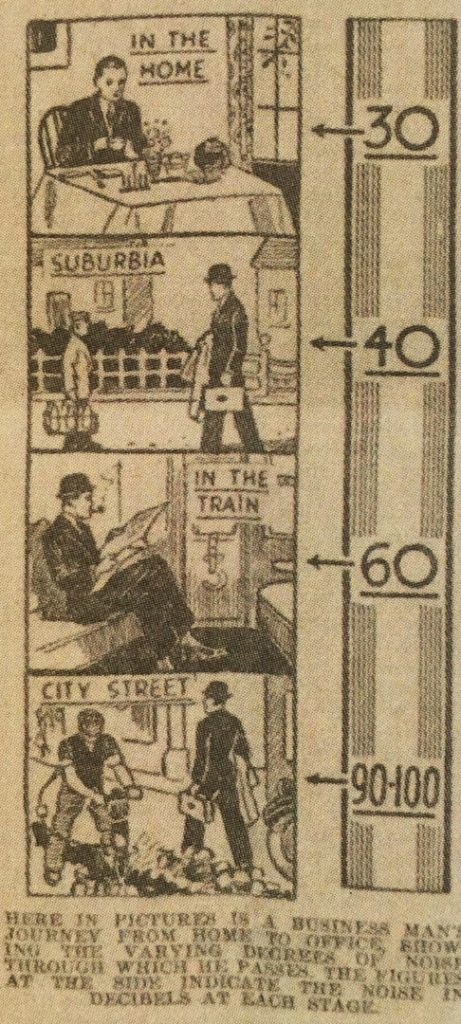
Despite this variation in outlook, the rest of the Science Museum Noise Abatement Exhibition more or less successfully conveyed the Anti-Noise League’s core message and way of hearing technological sound. Along with the mock thermometer, other visual illustrations of the threat posed by noise were included in the exhibition. The strategy of showing sound was indeed one of two core curatorial approaches employed at the exhibition. Although sounds themselves played an important role in the exhibition via demonstration, it was in fact just as useful to show sound, visually, to visitors because one of the key claims of the Anti-Noise League was that noise operated as an invisible but vibrant environmental force in urban areas causing an imperceptible drain on the nervous energy of those exposed to it. In a 1935 radio appeal, Lord Horder explained to people unconvinced by the noise abatement movement that ‘your resistance to noise, a great deal of which is endless and preventable, costs you something that you cannot afford to pay, and a lot of you are “overdrawn” already’. He added that ‘We British are very patient, very conservative, but we are also shrewd and businesslike. There is no more need to put up with this stupid expenditure of nerve energy, through needless noise, than there is to put up with the expenditure caused by bad housing, tainted food, impure water, or any other of the preventable conditions that destroy health.’ He promised his listeners, if they became ‘noise-conscious’, ‘a good return for your investment. I can promise you a gain in health, in security and in the enjoyment of life, which will amaze you when the nervous energy which you now spend on this endurance of unnecessary noise is released for the purposes of unhampered work and equally unhampered play. But remember,’ he added for the sake of urgency, ‘we must tackle the evil now, before it gets beyond our control.’[5] Back in 1928 the British Medical Association had been frustrated that the health effects of noise ‘cannot be shown on the stage of a microscope or in a jar of spirit’.[6] It was for this reason that visualisations of the physics of sound waves played a prominent role at the Science Museum in 1935.
These visualisations included a ‘sensitive flame showing different phonetic powers of spoken words’ lent by the Industrial Health Research Board, a live broadcast of speeches from the House of Commons into a tank of water to illustrate the different speeds at which sound travels through water compared to air, a ‘Telegraph arranged to indicate noise actually being made inside and outside the Exhibition’ lent by the Western Electric Company, a noise map of London, a model of Broadcasting House lent by the BBC lit up to ‘indicate the varying systems of sound proofing applied throughout Broadcasting House to studios, music chambers, etc.’, in addition to various noise meters lent by the National Physical Laboratory, contained in the research and development section of the exhibition, shown in Figure 5.[7]
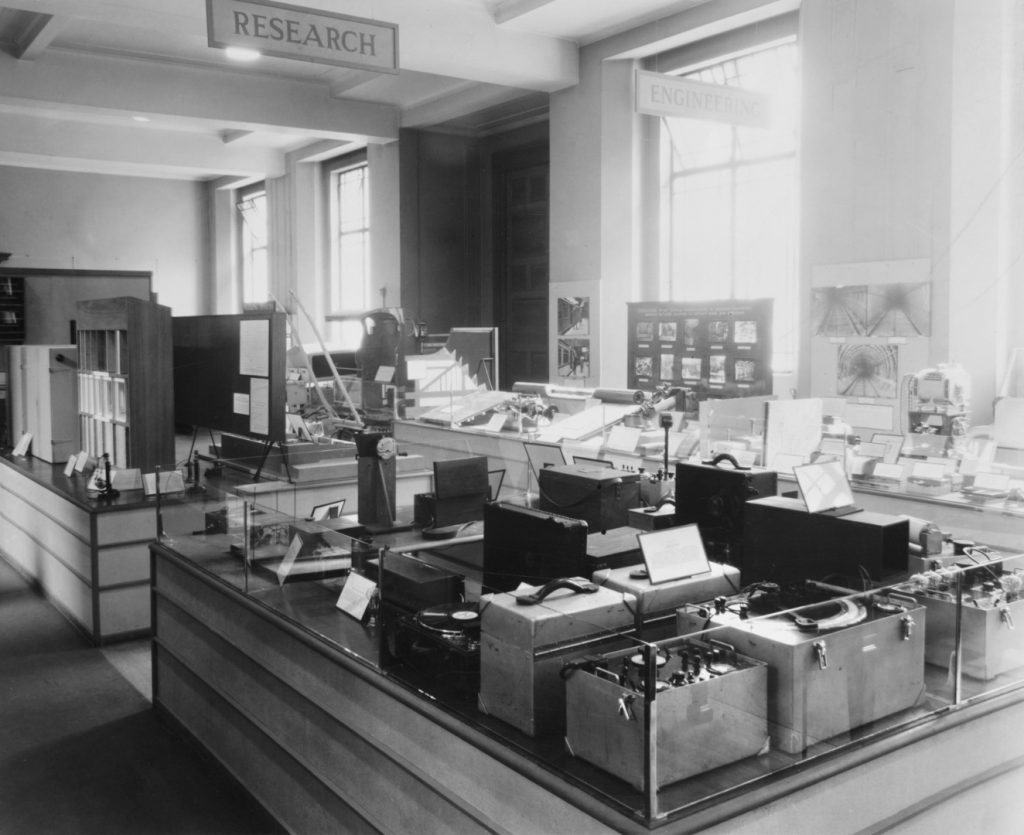
A dedicated cinema room showed two films supplied by Western Electric, Sound Waves and their Sources and Fundamentals of Acoustics, both made in 1933 by the University of Chicago. The films offered a basic introduction to the science of acoustics and were later circulated by Encyclopaedia Britannica Classroom Films for use in schools. In March 1935, the Anti-Noise League invited its members to view these two films in advance of the exhibition at a screening in the Cinematograph Theatre at Bush House, Aldwych. The purpose of the screening was to ascertain their suitability for the exhibition.[8] Sound Waves and their Sources (which can be seen in its later 1950s version below) includes a long section visualising the invisible vibration of sound waves emanating from a tuning fork. These various visual techniques for showing sound served to illustrate the Anti-Noise League’s argument that, even if you couldn’t see it, noise was acting in the background to drain your nervous energy.
The 1935 Noise Abatement exhibition is notable, though, for its use of sound as a technique of museum engagement and this was the second core curatorial approach adopted by exhibition organisers. ‘A chamber of noise horrors’ was how Lord Elton described the exhibition in the aforementioned newspaper coverage. Elton was no dispassionate observer as a member of the Anti-Noise League’s Council. He might well have been referring to the subject matter of the exhibition rather than directly to its auditory characteristics. It is clear, nonetheless, that from the beginning the exhibition organisers set out to use sound itself in the exhibition. It is difficult to ascertain how many of the exhibits were actually sounded during the exhibition, but the form which exhibitors were required to fill out asks some telling questions, such as ‘Do you propose to demonstrate? If so, how frequently?’; ‘Is demonstration possible by others than your own demonstrator?’; ‘Will your exhibit be suitable for indoor or outdoor demonstration?’; and ‘Does your exhibit require a special sound-proofed cubicle?’.[9] Significant provision was certainly made for demonstrators during the exhibition. The exhibition was staffed by members and associates of the Anti-Noise League at a dedicated ‘Information Bureau’ and beside individual exhibits. The most commented-upon sonic feature of the exhibition was the open-air demonstration of a silenced pneumatic drill (advertised, as in Figure 6, as the Holmon drill in the exhibition handbook), which took place regularly in the Science Museum courtyard. In newspaper reporting of the exhibition the Prime Minister, Ramsay MacDonald, who opened the exhibition on its first night, is shown operating the drill. Motorcycle exhausts were also sounded during the exhibition.[10]
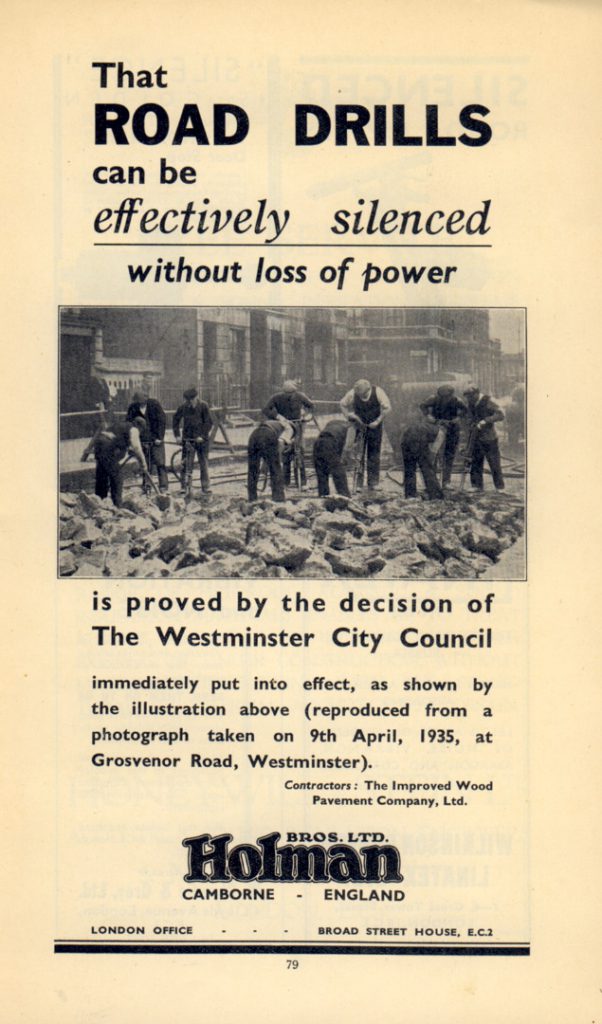
The centrepiece of the exhibition from the sonic perspective was, however, the demonstration house erected in the buildings section to showcase advances in architectural acoustics, building materials and quiet domestic technology. This was a full-size, two-storey house, on the scale and design of a typical suburban semi-detached dwelling. It was built especially for the exhibition by C W Glover, of consulting engineers C W Glover & Partners. Glover was a member of the Council of the Anti-Noise League and had made a name for himself by proposing to build an elevated airport in central London near King’s Cross Station. He became known later for publishing an influential pre-Second World War book on building for civil defence against air attack (Glover, 1938). His demonstration house was situated, together with the exhibition’s cinema room, in the annexe attached to Gallery 1, where the main exhibition was held, and was reached via a short flight of steps down onto its ground floor (Figure 7). Here the visitor would enter the house in a small entrance hallway called the ‘noise chamber’ leading on either side to two larger rooms, one constructed using ordinary building methods and the other, called the ‘silent room’, using the latest techniques of soundproofing. The second storey of the house consisted of one large room extending across all downstairs rooms.
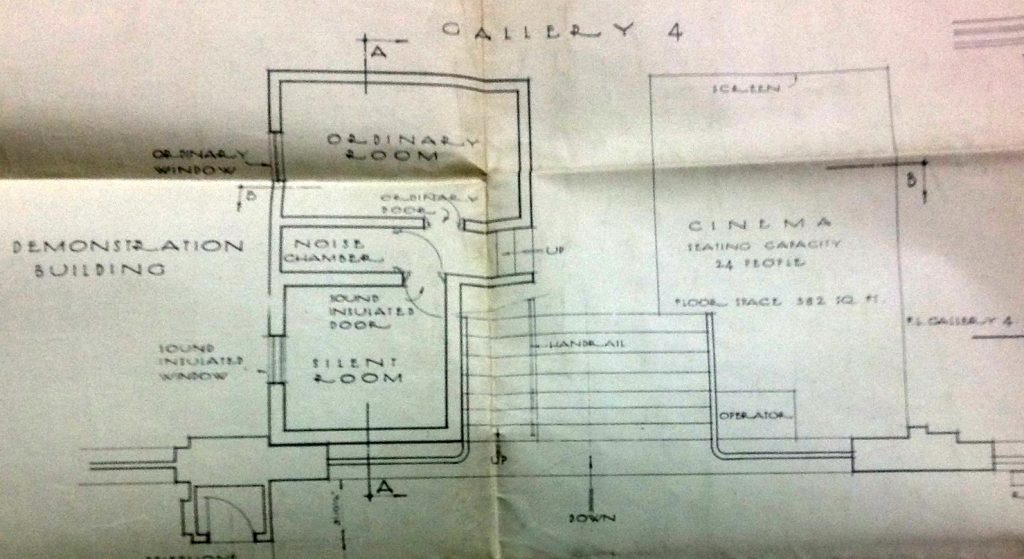
The diagram in Figure 8 shows that ‘contact noise machines’ (which were used at the National Physical Laboratory to simulate domestic sounds and in this case were fitted with shoes to simulate footsteps) were placed on the floor above both main lower rooms and that an undetermined ‘source of noise’, which was in fact a piano, was placed above the lower ‘noise chamber’. A description of the house written by Glover lists the exhibits on the upper floor as ‘ordinary’ (as opposed to silenced) technologies, and in addition to the piano these were a gramophone and a sewing machine. The gramophone and sewing machine, along with the piano, were operated by demonstrators so that their audibility, or otherwise, could be assessed downstairs by visitors. The hope was that in the downstairs rooms visitors might come to appreciate the value of different building techniques for the control of domestic noise. The piano, placed above the ‘noise chamber’, also extended across the ceilings of both the ‘silent’ and the ‘ordinary’ rooms and could ‘be heard in the latter but not in the former’.[11]
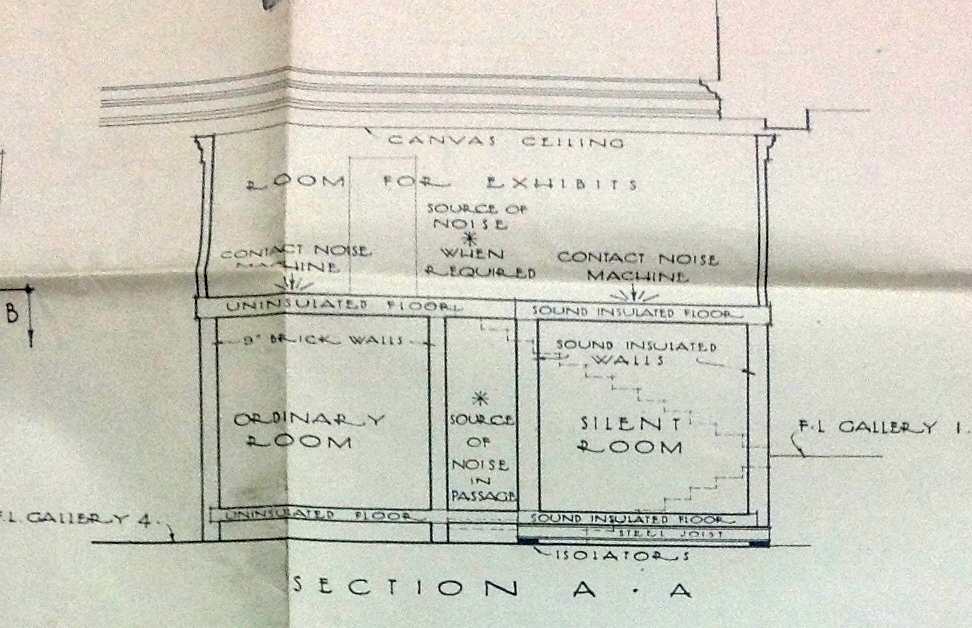
The varying acoustic qualities of the downstairs rooms were achieved through the different construction methods deployed in each one. The portion of upstairs floor above the ‘silent’ room was finished with a ‘floating floor’, a major acoustic innovation of 1930s house and flat building. This consisted of ‘an anti-impact type of covering consisting of battens at 14″ centres supported on rubber insulators of such a size and at such centres as to increase the loading on them to the optimum figure for the greatest dampening effect’. Glover explained that, ‘the weight and inertia of the floating surface are increased by the use of pre-cast loading slabs which rest in the battens’.[12] This ‘floating floor’ was promoted by H W Cullum & Co as the ‘Cullum Soundproofing System’ and can be seen in detail in the advert for the product which was published in the exhibition handbook (Figure 9). The ‘silent’ room was also physically separated from the rest of the building: a small air space was left between the parts of the upstairs floor covering the ‘ordinary’ and the ‘silent’ rooms. The walls of the ‘silent’ room had a quarter of an inch of rubber inserted between them and the concrete foundation raft below. The ‘silent’ room wall adjoining the ‘noise chamber’ consisted of two 4.5-inch brick walls with half an inch of air space between them. This wall also had a plastered 1.25-inch compressed reed panel on one side and plaster direct on to brickwork on the other. ‘The object of this panel,’ wrote Glover, ‘is to demonstrate the efficiency of this method of construction which is suitable for party walls in semi-detached cottages, flats and the like, provided no floor loads are carried upon the wall.’ Compared to the two 4.5-inch walls separating the ‘noise chamber’ from the ‘silent’ room, the wall on the other side of the hallway, adjoining the ‘ordinary’ room, was only 2.5-inches thick and had only a ‘skim coat of plaster on each side; a typical partition as used in offices and flats’. The ‘ordinary’ room was also missing the ‘acoustic plaster’ on the ceiling and ‘rubber floor covering’ used in the ‘silent’ room, which was also fitted with a soundproofed door and a soundproofed window, as indicated in Figure 7.[13]
Glover noted some clearly discernible auditory effects in the demonstration house which he hoped would be noticed by exhibition-goers. For example, he explained that the floating floor had a significant effect on the transmission of the sound of footsteps generated by the National Physical Laboratory’s contact noise machines: ‘Noise of footsteps penetrates easily to the ordinary room’ but is ‘rendered inaudible in the room below [the floating floor]’. It is evident from Glover’s descriptions that visitors were encouraged to take part in auditorily testing the demonstration house. ‘Ordinary conversation in the noise chamber cannot be heard in the silent room, but can be heard in the ordinary room… It is only necessary to raise the voice to be heard and understood distinctly through the plastered breeze partition.’ He also noted that while ‘Conversation in the upper room cannot be heard in the lower rooms…gramophone music from above is heard in the ordinary room and not in the silent room.’ As well as testing out the house with their voices and comparing this experiment to the transmission of the sound of the gramophone, it seems likely that exhibition visitors were encouraged to drop coins on the floor of the upper room for the benefit of their friends below. Glover recorded that ‘The height at which coins have to be dropped on to the various floor surfaces before the sound penetrates sufficiently to become audible below, affords another striking demonstration of the efficiency of the anti-impact type of floor.’ Visitors were certainly encouraged to attend the upstairs room because organisers went to the trouble of installing a lift especially for reaching the upper floor of the house. On their way to throw coins, visitors travelled in this especially-commissioned ‘silent lift’, captured in the exhibition photograph in Figure 10. Complaints about lift noise were among the main objections to living in blocks of flats in the 1930s (Mansell, 2017). The buildings committee contracted Hammond Bros. & Champness Ltd to supply their ‘special silent type’ lift which was ‘designed for silence with rubber buffers or air checks to every moving part’. The lift gates had ‘special tracks and rubber buffers between all fittings’ and ‘Between the motor room and the roof of the building’ was ‘a ventilated noise chamber designed to dissipate any noise’.[14]
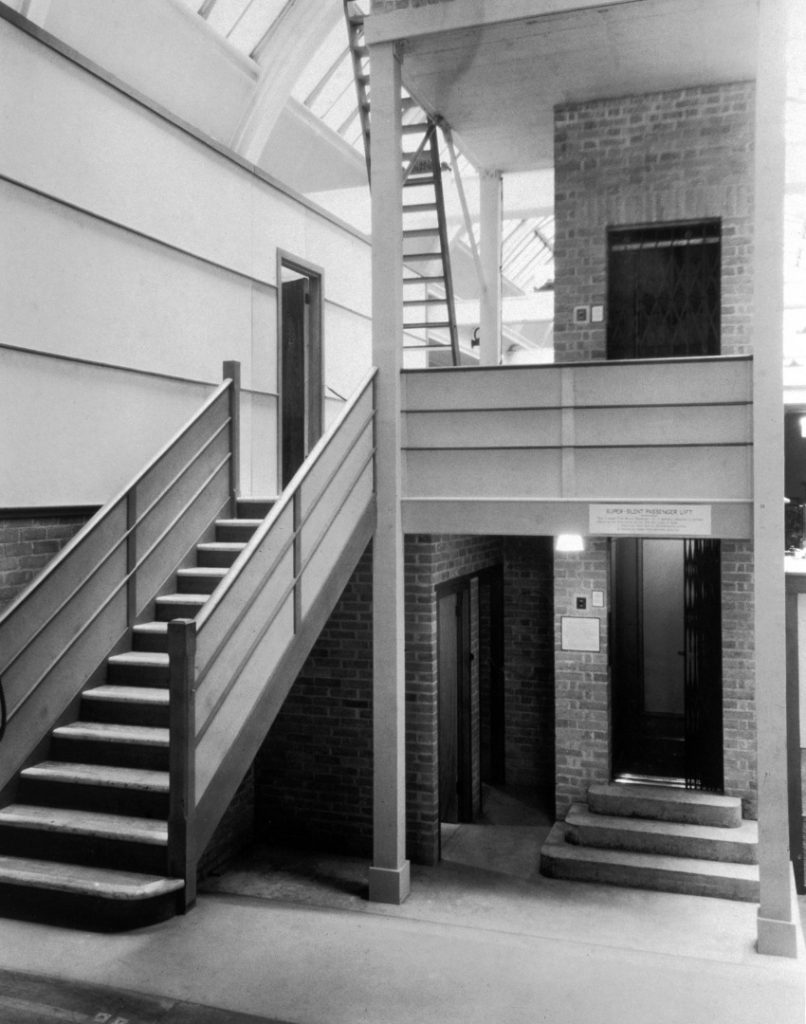
There were further opportunities for visitors to the demonstration house to compare the acoustic properties of building methods and technological objects. Downstairs, demonstrators shovelled coal on to the fireplaces installed in both the ‘silent’ and the ‘ordinary’ rooms. While the ‘ordinary’ room had a standard hearth, the ‘silent room’ had an asbestos pad fitted below the fireplace to deaden the sound of the coal as it was shovelled. Visitors were also encouraged to compare the soundproofed and the ordinary window by listening to the sound of an electric bell rung in the gallery annexe outside the house. Finally, in response to social survey findings that indoor toilet plumbing was among the most complained about domestic noises (Mansell, 2017), the demonstration house was fitted with a ‘silent lavatory’ as well as ‘The use of “air cushioning vessels” and easy bends in domestic plumbing’ to show how better design would lead to less bathroom noise. The house provided the opportunity not only to demonstrate the effect of new construction methods on the control of sounds made by ordinary technologies such as the gramophone, put also provided an ideal stage for the demonstration of new ‘quiet’ and ‘silent’ technologies. Minutes kept by the buildings section sub-committee indicate that, for example, an ordinary typewriter was placed in the ‘ordinary’ downstairs room, so that it could be compared, auditorily, to the ‘silent’ typewriter placed in the ‘silent’ room. Although the committee records do not specifically indicate it, the advert for the Underwood Noiseless typewriter which appeared in the exhibition handbook (Figure 11) suggest that this was the model used in the ‘silent’ room.[15]
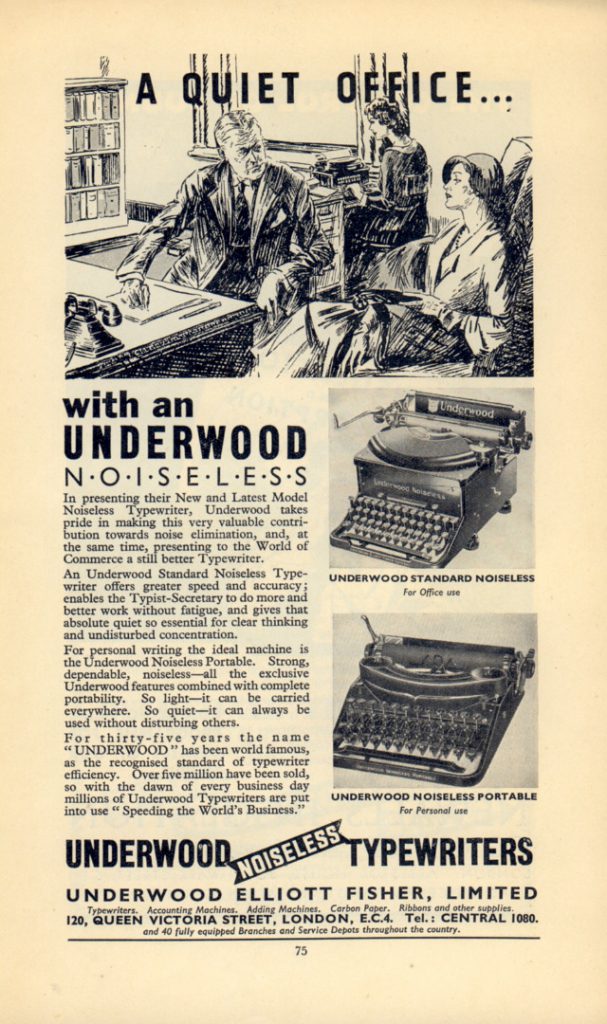
Indeed, a portable Underwood Noiseless typewriter was acquired for the Science Museum’s permanent collection following the Noise Abatement Exhibition. Committee records indicate that plans were also made for the demonstration of other ‘quiet’ technologies, such as vacuum cleaners like the one shown in the Electrolux advert included in the exhibition handbook (Figure 12), which was placed alongside an advert for another silent typewriter, the Continental Silenta.
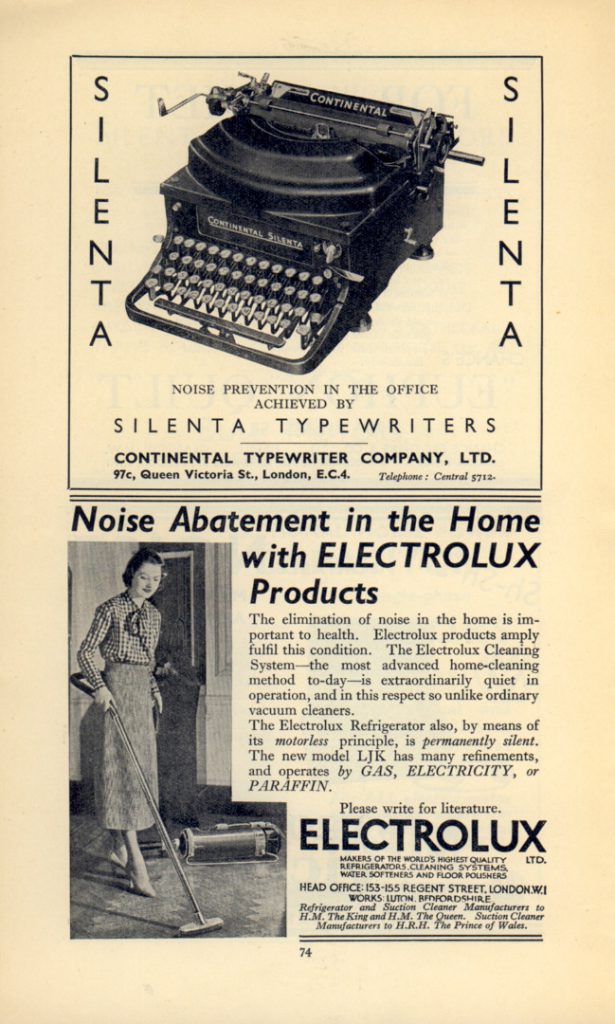
It is evident, therefore, that the demonstration house was conceived as a sounding exhibit where visitors would interact with their ears more than with their eyes and where demonstrators, provided by the Anti-Noise League and by companies such as Cullum & Co, would curate an auditory experience for exhibition-goers. It is also evident that such auditory engagement was not provided simply for the purposes of immersive entertainment, but rather sought to cultivate the listening subjectivity of visitors (or an imagined visitor), encouraging them to become discerning consumers of better-sounding houses and quieter technologies. The demonstration house acted in some ways like a nineteenth-century concert hall, directing listeners’ attention to good quality sound and offering them an education, and a bodily training, in how to hear, as well as how to sound, in a civilized way. Indeed, what visitors were being trained to hear in the demonstration house was not so much noise, but rather quiet, to appreciate both the scientific and social significance of this in-between acoustic category. The Anti-Noise League’s hope was to draw attention not just to the possibilities of new engineering and building techniques, but also how to behave in a civilized way with one’s gramophone or one’s wireless set at home. The demonstration house, modelled on the inter-war building schemes that aimed to overcome slum living in cities, was just the kind of place where a working-class person of a certain status might learn how to acquire middle-class aural proclivities, to enter the bourgeois auditory habitus. Bagenal indicated the class specificity of the demonstration house by suggesting in his notes that flats for middle-class people would ideally need higher standards of sound design than those shown in the house. ‘In the case of middle-class flats,’ he wrote, ‘the needs of persons wanting quiet in buildings of moderate cost could well be met in special blocks of flats in which ear phones only were permitted and where a clause in the lease insists on carpets on all floors. This could well be supplemented in this class of flats by restriction upon dogs and gramophones.’[16]
Given what we know, however, about the Anti-Noise League’s emphasis on the need to save the ‘intelligent section’ of society from noise, we can interpret the demonstration house less as a place where working-class ears and nerves would be saved from noise, and more as a place where they would learn a quieter way of life to be reproduced for the benefit of the already cultivated male, professional, hearer. Quiet, as well as noise, was invested in the context of inter-war noise abatement with clear class and gender characteristics, and the education in these sonic categories offered by the 1935 Noise Abatement Exhibition contained clear traces of this social content of sound.
Conclusion
https://dx.doi.org/10.15180/170704/005Sound is part of the social and material history of technology. Recovering the sound of a machine, however, is not enough to understand the context of how technology was heard in the context of its first use. Museums of science and technology can recover this history, but as the case of the 1935 Noise Abatement Exhibition shows, they might also have been implicated in creating ways of hearing technology in the first place. The Anti-Noise League understood that to wage its campaign against ‘needless noise’ it needed to attune people to an anti-noise way of hearing. An exhibition at a major national museum such as the Science Museum was a golden opportunity to do so. What the Anti-Noise League understood only too well, museum theorists and practitioners perhaps need to consider afresh.
The Science Museum’s 1935 Noise Abatement Exhibition sought to attune the auditory attention of its visitors, to cultivate listeners, by making them aware of what and how they heard. It encouraged a way of hearing that cast technological noise as unhealthy and uncivilized, but, more than that, promoted quietness and auditory isolation as norms for social life. Truly noisy phenomena were not the main auditory features of the exhibition and were depicted visually rather than auditorily, as in the case of the jet engine or the unsilenced pneumatic drill shown on the mock thermometer in Figure 3. These were the ‘noise horrors’ described by Lord Elton. Ultimately, his and the Anti-Noise League’s concern in the exhibition was not so much with educating visitors to hear these horrifying sounds, but rather in encouraging them to reconsider the need for, as well as the acoustic qualities of, quietness. Elton imagined a visitor leaving the exhibition with the confidence, when confronted by a friend ‘speaking too loudly’, at an unnecessary ‘60 phons’, to say, ‘“Please bring your voice down to about 20 phons”.’ He added that ‘Most of us speak louder than is necessary, and louder than we did a few years ago, for we are so accustomed to shouting against the noises that surround us in restaurants, factories, and shops that we take the habit to our homes’.[17] The exhibition was thus in fact a chamber of potential noise horrors; the noises presented there were already in the process of being reshaped to conform to the middle-class ideal of quiet promoted by the Anti-Noise League. Visitors heard not a regular pneumatic drill, but rather a silenced one. The demonstration house described above invited visitors to hear themselves and their own actions within the dynamic process of transformation from noisiness to quietness. They would step out into the world, it was hoped, with a new appreciation for quiet and with a greater appreciation of one’s own responsibility to keep the peace. The exhibition thus actively disciplined its visitors as auditory subjects, offering an embodied education in the superior sonic values of the ‘quiet’ classes and their appreciation for higher standards of acoustic design. The presentation of sound at the exhibition was thus socially active: its planners understood that social ideals could enter into acoustics, for example in the demonstration house.
The exhibition presented quietness as a rational aim of scientific and technological innovation for the purposes of lending objectivity to the cause of noise abatement, but this cause was an auditory concretisation of class and gender hierarchy as much as it was a public health campaign. Sound studies scholarship shows that this exhibition case study is the norm rather than the exception where the cultural and social history of sound is concerned: sound is no less socially-interested than vision, no less a useful resource for the creation of truth effects, social hierarchy and cultural control. These are lessons for the museum curator to absorb. In creating exhibitions of or with sound, we must begin with critical awareness of sound’s place within the contested terrain of history rather than just a new technique for enlivening it.
Acknowledgments
The author wishes to thank Tim Boon, Aleksander Kolkowski, John Liffen and Jennifer Rich, all of whose support was invaluable in the researching of this article.
Tags
Footnotes
Back to text
Back to text
Back to text
Back to text
Back to text
Back to text
Back to text
Back to text
Back to text
Back to text
Back to text
Back to text
Back to text
Back to text
Back to text
Back to text
Back to text

